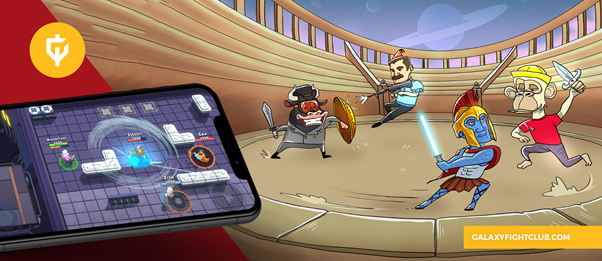If there’s one thing we know about video games, it’s that fighting never goes out of fashion. Forget ‘toxic masculinity’, both guy and gal gamers love nothing more than slaying their virtual enemies, whether with a sword, a bolt of lightning, an AR-15 or some other weapon engineered for maximum devastation.
From Mortal Kombat to Call of Duty via Tekken and World of Warcraft, games that have conflict at their core are some of the industry’s biggest hits. And nothing has changed since the emergence of blockchain-based gaming, where the objective is to invariably sack and plunder rival territory while pocketing crypto loot as you go.
Once More unto the Breach
Releases like Galaxy Fight Club (GFC), which describes itself as the first-ever cross-IP, cross-platform (PC & mobile) PvP fighting game, seek to pay homage to the battle-based video games of old while catering to modern, NFT-savvy players. The premise of GFC is simple: players log in using either their favorite third-party NFT (Bored Ape Yacht Club, CyberKongz, etc) or native character NFT, then wage war with other competitors to win rewards and earn payouts.
There is actually a precedent for this model: Nintendo’s crossover fighting game Super Smash Bros, originally released in 1999, was envisaged as a means by which various characters in the wider Nintendo universe could live in the same domain. Of course, GFC’s idea is a tad more ambitious since it seeks to bring characters from multiple rival platforms into the same ecosystem.
Interoperable out of the box, Galaxy Fight Club’s goal – aside from entertaining a legion of bellicose gamers – is to be a unified platform where various siloed NFT projects and their users can come together, interact, and of course, throw down. According to the GFC team, all major avatar projects are likely to be incorporated into the game over time, whether there is a partnership between the ventures or not. Unlike in the legacy gaming sector, this is possible because NFT rights typically belong to the individual owner rather than the collection itself.
Galaxy Fight Club recently sold close to $10 million worth of NFTs that formed its Genesis Collection, some 10,127 fighters native to the game. According to nft-stats, the most valuable – a mustachioed, club-wielding Centurion called Galaxy Fighter #5041 – is currently worth around $33.2k. Not bad for a game that’s just launched.
Players don’t need to have a Genesis NFT or a third-party one to participate, of course: avatar-less competitors will be allocated a default fighter with base stats and a default, base-tier weapon when they sign up. If they perform well in the game, they can gradually increase their character’s strength through buying/winning clothes and armor and obtaining a superior weapon.
Ruling the Galaxy
So how do the play-to-earn mechanics work? Well, in a nutshell, players win by triumphing in battle and earning keys needed to unlock loot boxes, treasure chests that contain various goodies including weapons.
The type of key received depends on the avatar you’re controlling: if it’s a free base character, they are silver and can be sold directly on the marketplace or used (alongside $GCOIN, the game’s native token) to open loot boxes; if you’re the proud owner of a Genesis NFT, 2nd generation fighter or Genesis Collection weapon, the keys are gold and grant entry to tournaments offering richer prizes.
If you’re playing with a non-GFC character, meanwhile, you’ll earn keys that open loot boxes containing partner-specific tokens and rewards. These items may come with additional utility outside of the game and can also be sold on for ETH.
Apart from the kudos that comes from owning a Genesis Galaxy Fighter, owners of such NFTs enjoy an additional benefit: each one automatically accrues 5-15 $GCOIN per day.
Although the main game mode is built around bloody 3-vs-3 matches that last 5 minutes (whichever team makes 20 kills first wins, naturally), there are other modes such as Classic Death Match and Battle Royale. Players can alternatively focus on breeding/training 2nd generation fighters by ‘burning’ (removing from circulation) weapons and paying a training fee in $GCOIN.
2nd generation fighters, like their Genesis forebears, earn golden keys, enable tournament participation, and grant access to an exclusive Discord channel. They can also be sold on the secondary market.
Let the Battle Commence
The competition between rival GameFi projects is fierce. This is why it’s refreshing to see a platform like Galaxy Fight Club try to restore a sense of harmony – ironically by allowing various NFTs to maim and massacre each other.
The first rule of Fight Club was famous that “you do not talk about Fight Club.” Galaxy Fight Club, though, is different: and if its creators have their way, we’ll be waxing lyrical about its fast-paced gameplay, multiple earning mechanisms, and various battle modes till the cows come home.
